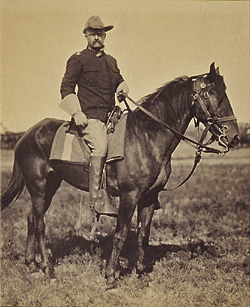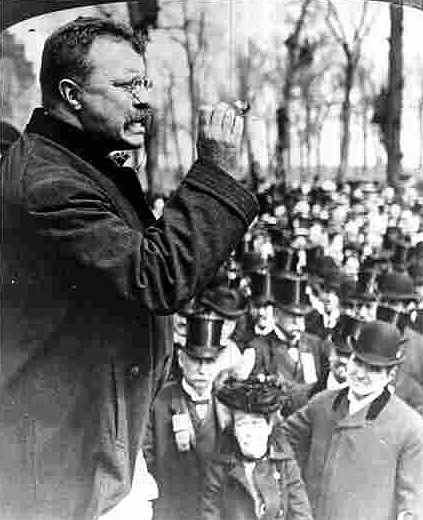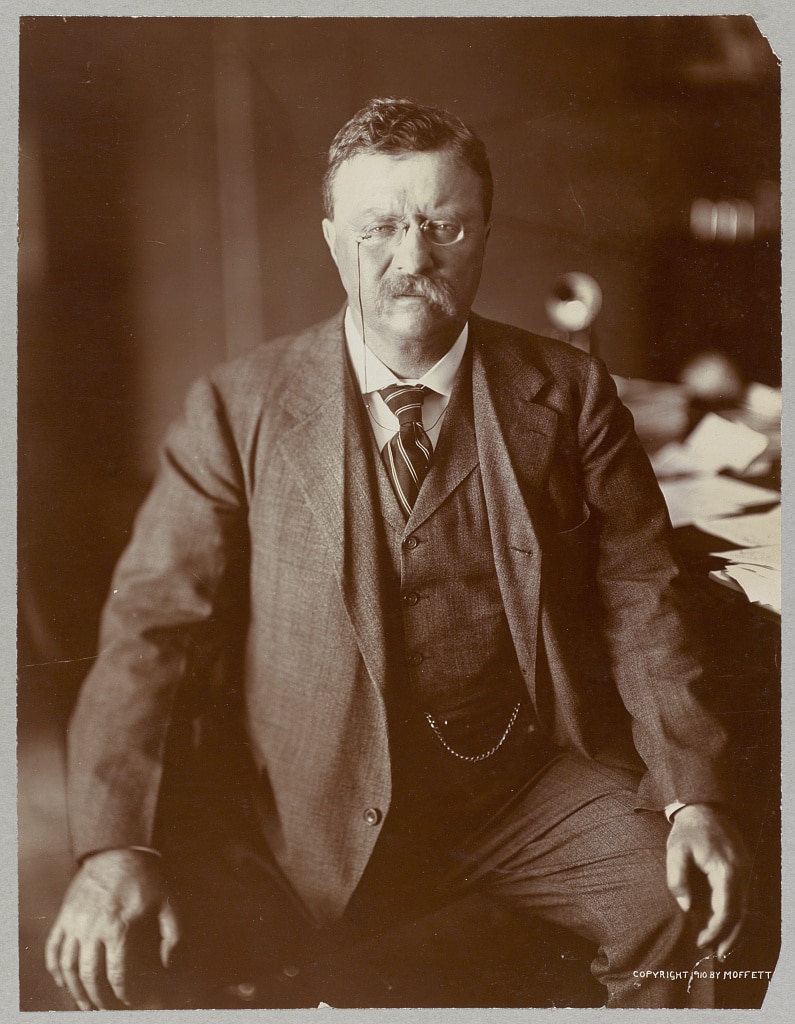Editor’s note: Theodore Roosevelt had a keen interest in martial and combative arts, beginning with boxing as a young man, and later as president — after a blow blinded him in the eye — focusing on wrestling and grappling. While in the White House, he first took jiu-jitsu lessons from Professor John J. O’Brien, who had learned the art while working as a police inspector in Nagasaki, Japan. According to a 1902 article in the New York World, Roosevelt “hope[d] soon to be able to break the arms, legs or neck of any Anarchist or thug who may assail him.”
Later, TR was taught jiu-jitsu and judo (while now distinct, he used the terms interchangeably) three times a week, for three years, by Japanese master Yoshiaki (Yoshitsugu) Yamashita. Roosevelt loved practicing jiu-jitsu (his ardor would help popularize it with Americans) as well as good old fashioned wrestling, and he would ask any and all companions and visitors — from diplomats to cabinet members to his wife and sister-in-law — to grapple with him. TR’s unflagging enthusiasm and burly frame eventually wore out even Yamashita, who told a journalist that while Teddy “was his best pupil…he was very heavy and impetuous, and it had cost the poor professor many bruisings, much worry and infinite pains during Theodore’s rushes to avoid laming the President of the United States.”
If you want to learn some of the vintage jiu-jitsu moves TR once practiced, below you’ll find the book (condensed) his original instructor, J. J. O’Brien, published in 1905.
Bully!
“A noble soul dwells in a strong body.” —Japanese Proverb
We know that you will find interest in reading and demonstrating to your own satisfaction the effectiveness of Jiu-Jitsu, in its mildest form, as a means of self-defense.
This is the first time that all the secrets of the Japanese national system of training and self-defense have been given to Western people. Less than a generation ago you could not have obtained this knowledge at any price. So religiously have the principles of Jiu-Jitsu been guarded that no foreigner has ever before received official instruction from one who has taken the highest degree in the art.
Jiu-Jitsu is the most wonderful physical training the world has ever known. It is a science. It is muscle dominated and directed in every detail by brain. The Japanese are the hardiest race of people in the world to-day, and we attribute their wonderful strength and power of endurance solely to the persistent practice of their national system of physical development. Jiu-Jitsu develops every muscle and strengthens every organ in the human body. It does not produce knotted muscles, but develops the body harmoniously and uniformly. It affects those minute muscles which are not reached by any other system. It strengthens the heart action, scientifically renews and invigorates every tissue, and helps every organ to perform its functions. The man or woman who devotes ten minutes daily to the practice of Jiu-Jitsu will enjoy a degree of health and strength that will make him or her thoroughly alive and fully conscious of the possession of perfect manhood or womanhood.
As a means of self-defense, Jiu-Jitsu is as potent at short range as the most deadly weapon that human ingenuity has devised. A Japanese skilled in this art has no fear of any form of personal attack. He will even defend himself unarmed against a swordsman and emerge from the combat victorious. The science of Jiu-Jitsu takes into account the vulnerable points in the human body. It comprehends the laws of mechanics, thus enabling the weak to overthrow the strong. One unskilled in the art is entirely at the mercy of the expert Jiu-Jitsuian, no matter how unequally matched in point of size or strength the contestants may be. An opponent may be overcome and remain unharmed if it be the will of the operator, or he may be seriously disabled by a slight pressure exerted at a vulnerable point, or a sharp twist of the arm, as to be rendered utterly helpless and unable to renew the attack.
The full-page illustrations in this book show the holds and locks of Jiu-Jitsu and represent Professor J. J. O’Brien, who was for many years a resident of Japan and received his diploma as Professor of Jiu-Jitsu from the Japanese Government.
Prof. John J. O’Brien came to America well known and highly recommended by the Japanese Government, and it was he who introduced Jiu-jitsu into this country, first in Washington, D.C., by giving instruction in the art to President Roosevelt, members of his Cabinet, and heads of many of the departments in Washington, and, says the New York Sun, “Jiu-Jitsu, the Japanese system of physical training, has become a popular fad at the Capitol under the President’s example, who, through persistent practice, has become an expert in the art, and as told in the news dispatches, is anxious to have Jiu-Jitsu introduced in the course of training at the Naval Academy.”
We give in this book twenty-eight illustrated lessons in Jiu-Jitsu, by Prof. John J. O’Brien and James Clinton Gavigan, one of the world’s greatest Physical Culture instructors. No apparatus whatever is required, and an ordinary room will suffice in which to perform the exercises. It is necessary to have a friend who is equally interested, to practice with you, as it adds pleasure and zeal to the work, and you will be surprised to find how rapidly you become familiar with the subject.
The practice of the modern system of Physical Culture needs a good deal of self-denial because there is little to keep up the interest; but with Jiu-Jitsu it is entirely different. A tilt with a companion has a great deal of pleasurable anticipation, and in combat there is always that uncertainty of success in offensive moments which makes one keenly alive to the situation.
It does not matter who the companion may be, a man of unequal strength, or husband and wife, brother and sister, may join in the friendly contest and each derive equal pleasure and benefit therefrom.
Lesson #1
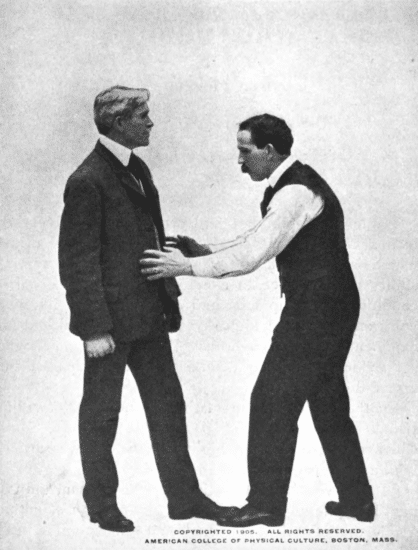
This lesson shows how a weak person could stop an opponent who is about to clinch…
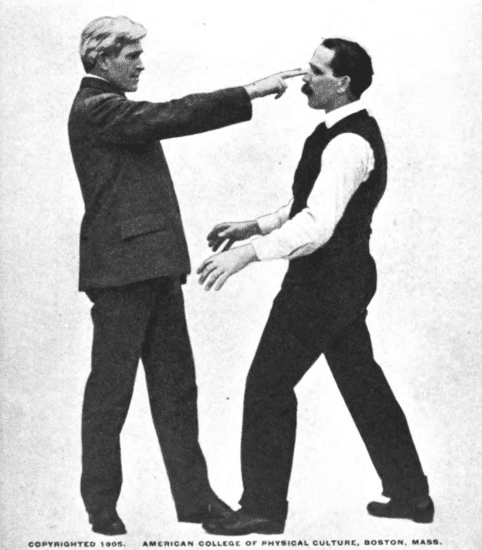
…by putting the first and index fingers to the eyes. This method was used by the Japanese at Port Arthur in the hand-to-hand battle with the Russians.
Lesson #2
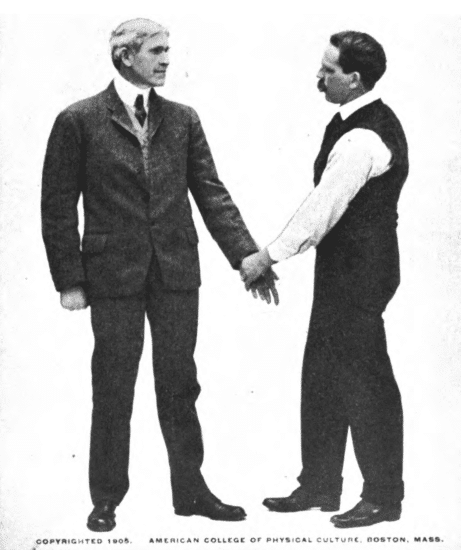
Take your opponent by the left hand firmly, as above illustrated.

Raise the left arm, turning your opponent’s wrist inward with your left; slide your right under your opponent’s left.
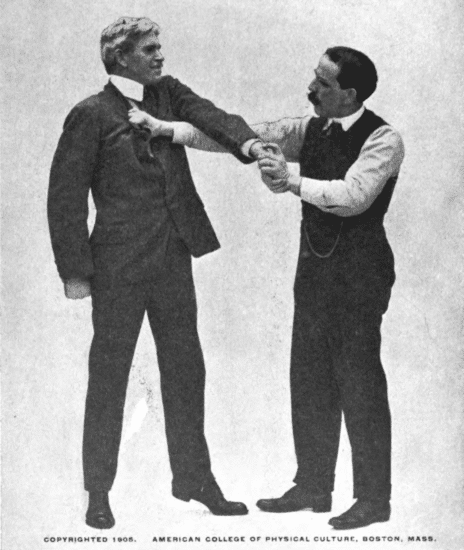
Grasp your opponent’s lapels firmly; stiffen your right arm, pushing your opponent’s left from you until it rests on your right forearm. At the same time twist your opponent’s left wrist inwardly and down.
Lesson #3
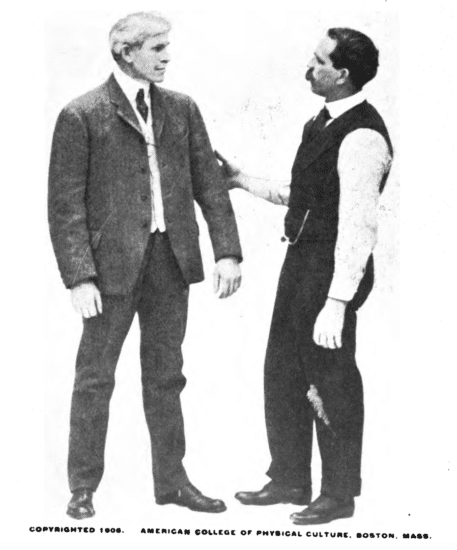
Place your right hand on your opponent’s left arm at the elbow.
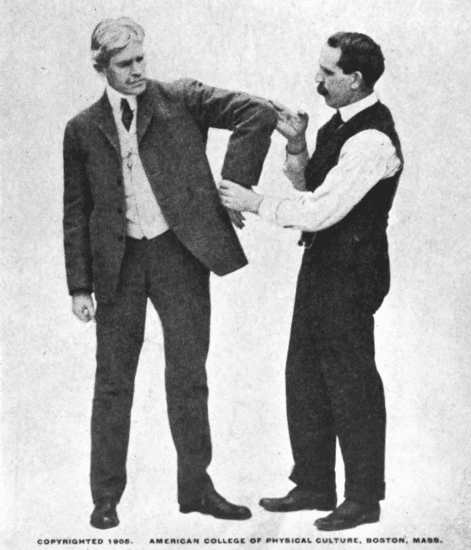
Take your opponent’s left hand at the wrist with your left, raising it inwardly, using your right to push his elbow forward.
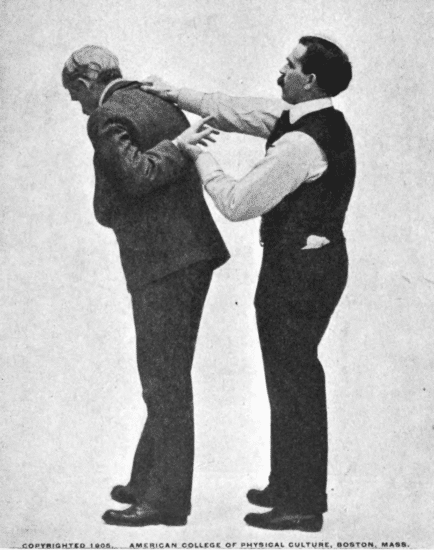
This will turn your opponent so his back will face you. Draw his left arm up, twisting the wrist with your left, taking a firm hold of your opponent’s coat collar with your right.
Lesson #4

Place your right hand on your opponent’s left arm at the elbow.

Take your opponent’s left hand at the wrist with your left, raising it inwardly, using your right to push his elbow forward.

This will turn your opponent so his back will face you. Draw his left arm up, twisting the wrist with your left, taking a firm hold of your opponent’s chin with your right and twist his head backwards.
Lesson #5
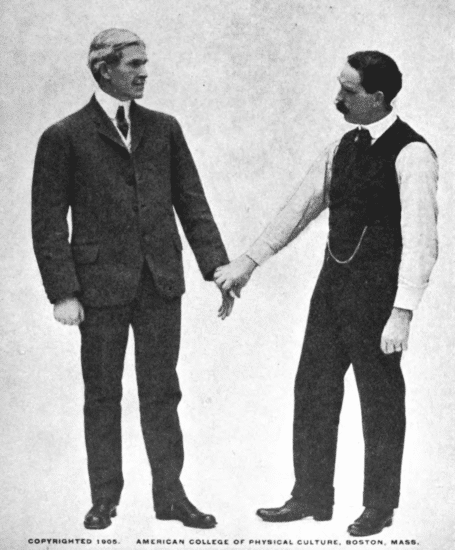
Take your opponent’s left hand with your right so your thumb will rest on the back of his knuckles and your four fingers on the ball of your opponent’s hand.
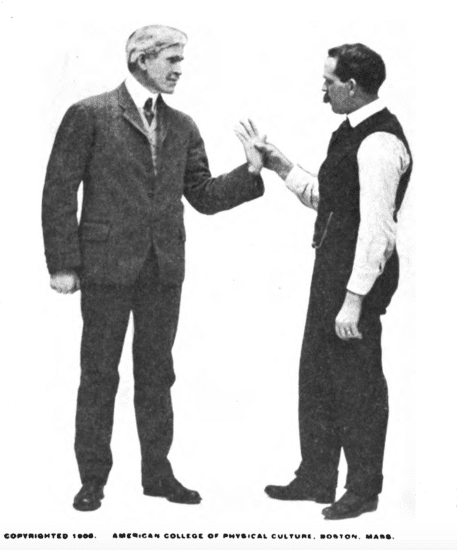
Raise his hand as shown in the above illustration, hold it firmly.
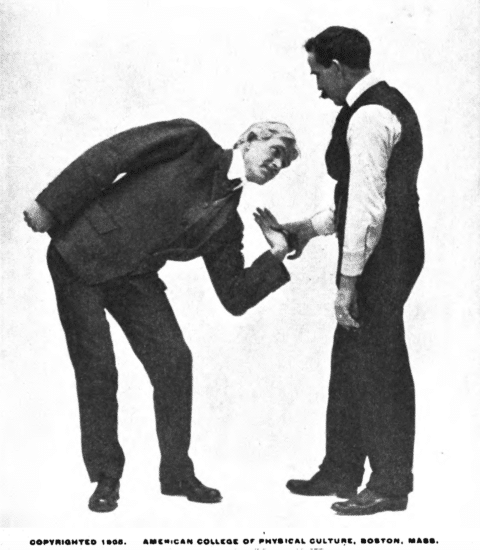
Press your opponent’s hand backwards with your thumb and at the same time twist his hand to the right with your fingers.
Lesson #6

Should a person make an attempt to strike you with either hand…
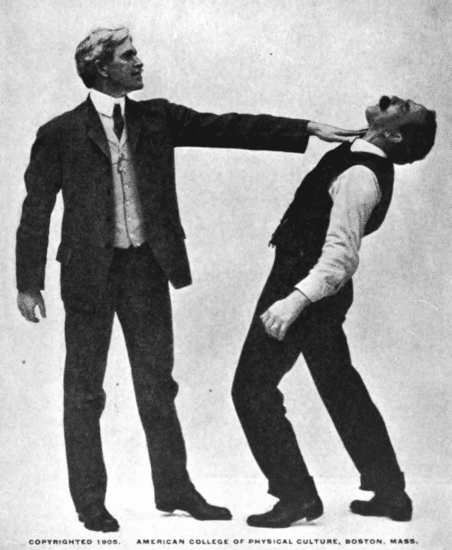
…stiffen the fingers of your left hand and strike your opponent in the neck.
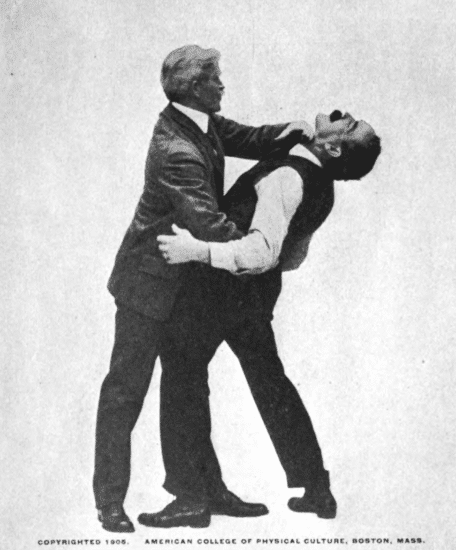
Follow this up by placing your right around his waist, drawing him closely to you and pressing firmly on his neck with your left.
Lesson #7
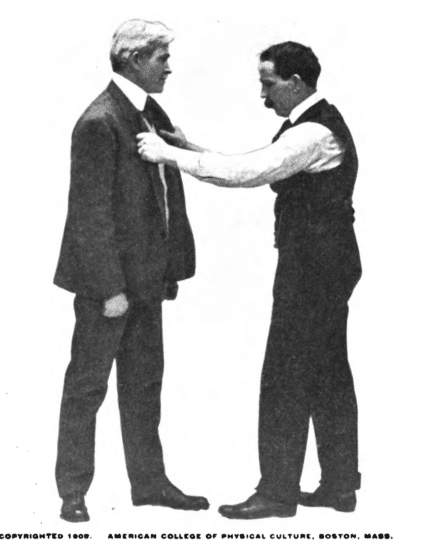
Take your opponent firmly by the lapels of the coat, drawing him to you.
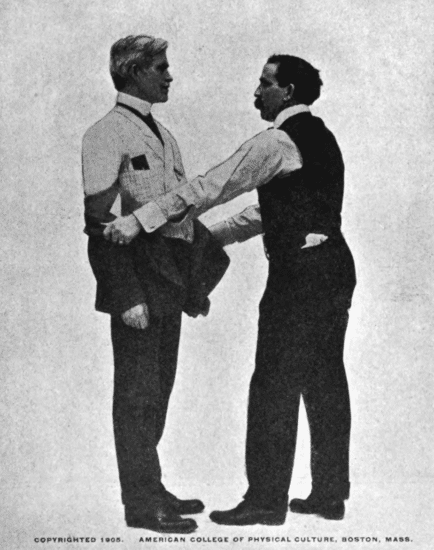
Throw the coat over his shoulders, drawing your opponent’s arms firmly together.
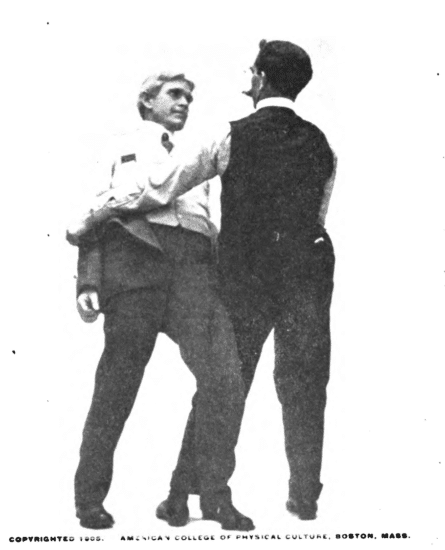
Step to right quickly, placing your left leg behind your opponent’s left, giving a sudden push backwards and to the right will result in a throw.
Lesson #8
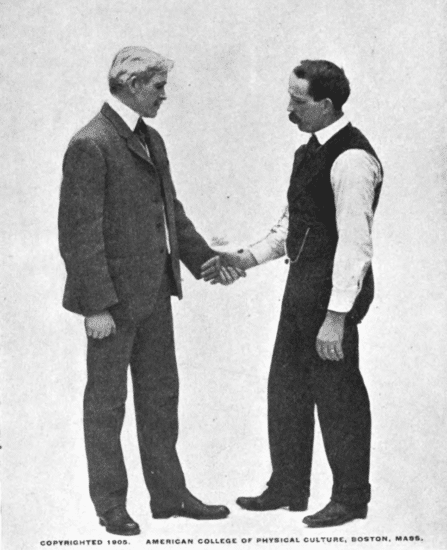
Grasp your opponent’s right with your left so as your fingers will rest in the centre of his hand and your thumb or the back of your opponent’s, close to the wrist.
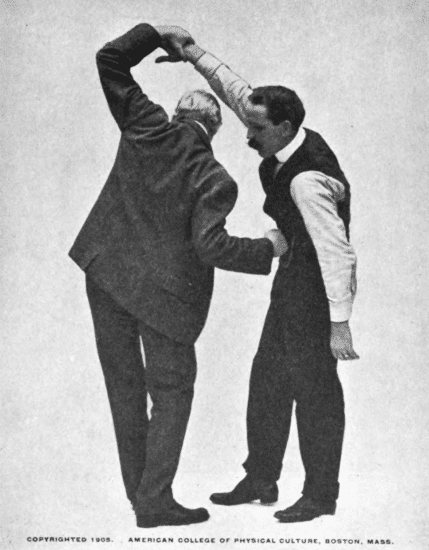
Raise your opponent’s arm over your head, striking him in the solar plexus with your right, holding firmly with left, going under as indicated by the above illustration.

As shown by the above you have your opponent’s right arm twisted and in a position where he is at your mercy.
Lesson #9
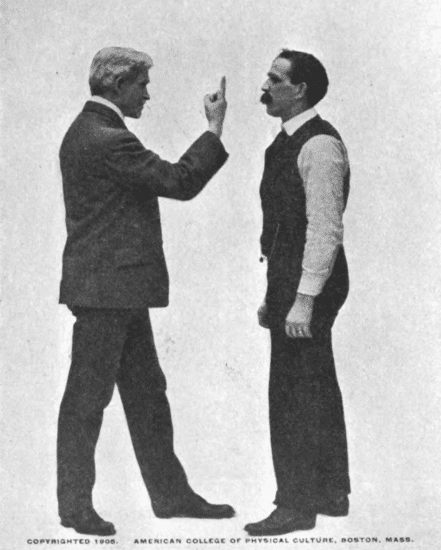
Should a person shake his finger in your face and about to strike…
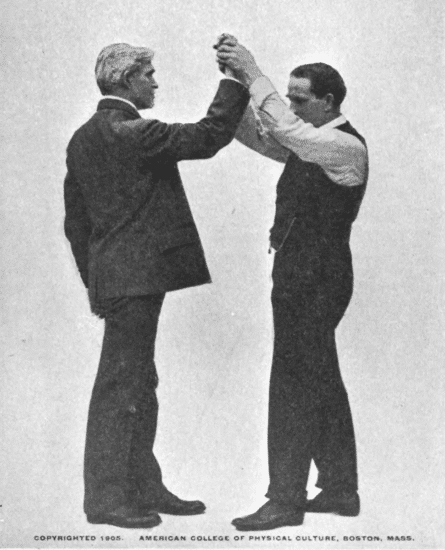
…take a firm hold with both your hands so your thumbs will rest on the back of your opponent’s hand.

Press the hand back with your thumbs and at the same time twist your opponent’s hand to the left and downward.
Lesson #10

Take your opponent’s right, using your right so that thumb will rest on the back of his hand and your first three fingers in the palm of your opponent’s.
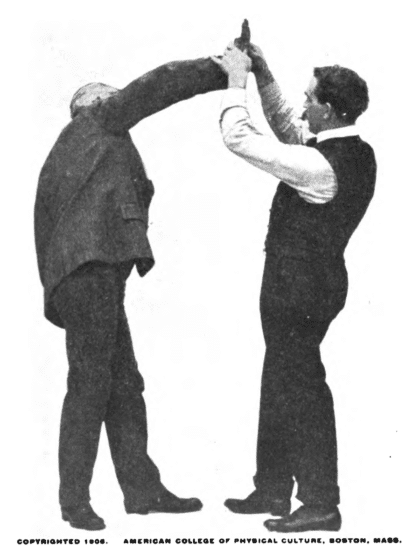
Step to the left; raise your opponent’s arm, taking hold with both hands…
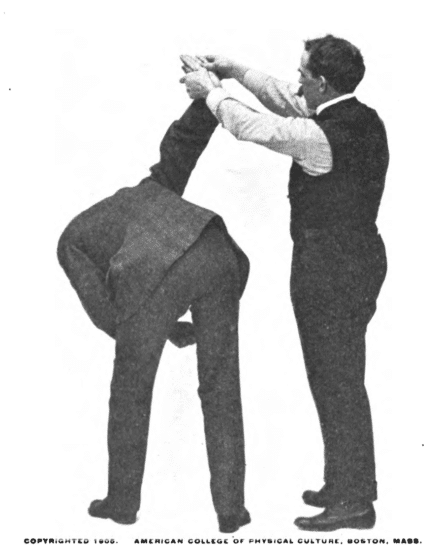
…pressing inward and twist to the right. You should always keep your opponent’s arm raised, which will cause him to bend forward.
Lesson #11

Should a person take hold of you by the lapel of your coat with intentions of causing you bodily harm…

…and you should try to break the hold after your opponent had you by the back of the neck…
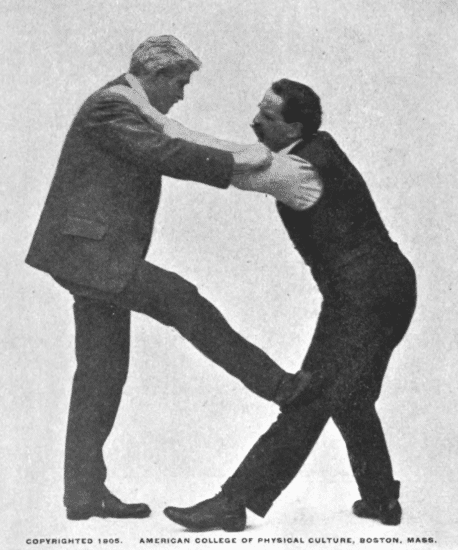
…hold him firmly by the arms with both hands, raise your right leg, pressing it firmly against his left, above the knee, as above illustrated. You will find it very effective.
Lesson #12
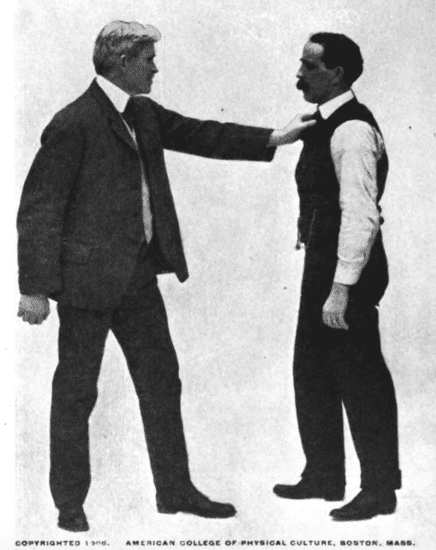
Should a thief reach to steal your pin or diamond stud on the street or in a public place…
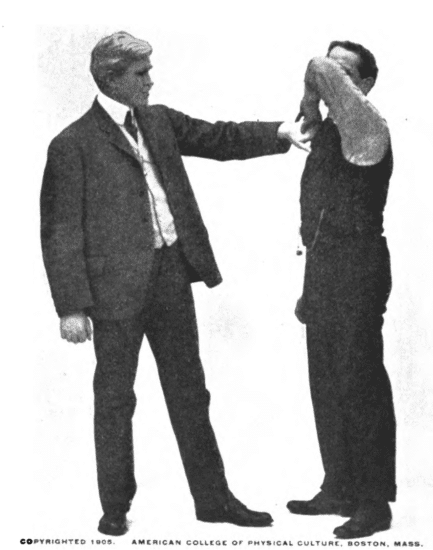
…use your left hand, placing your three first fingers firmly on his hand, forcing his arm to the left.

Take two steps to the right, holding your opponent’s arm upward, and you will have him at your mercy.
Lesson #13

Take your opponent’s right with your left firmly by the wrist as above illustrated.
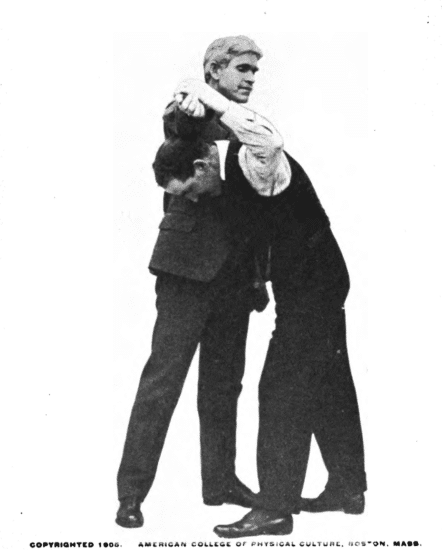
Twist your opponent’s arm to the left as you are about to raise it; at the same time go under, holding firmly with your left.

Place your right to your opponent’s throat, taking a firm hold, pressing downward with your left; you can either choke your victim or break his arm.
Lesson #14
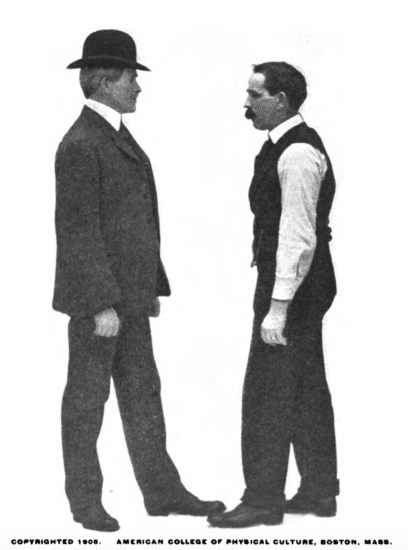
Should you get into an argument with a person and have your hat on, which is sometimes the case…
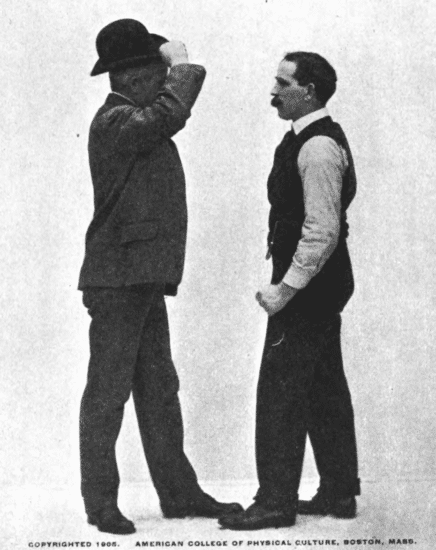
…and you are about to be attacked, pretend to raise your hat a casual way with your right hand.
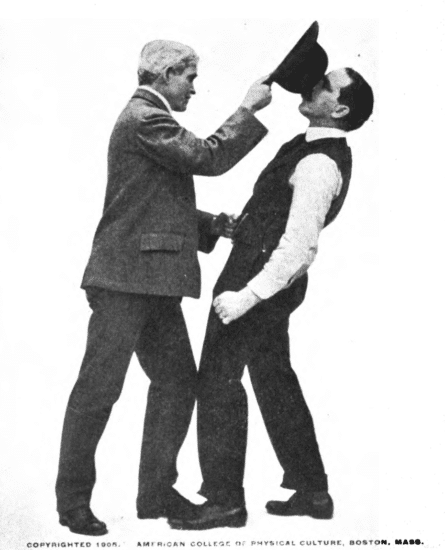
Lean forward, striking your opponent in the face with your hat and using your left, sending it to his solar plexus.
Lesson #15
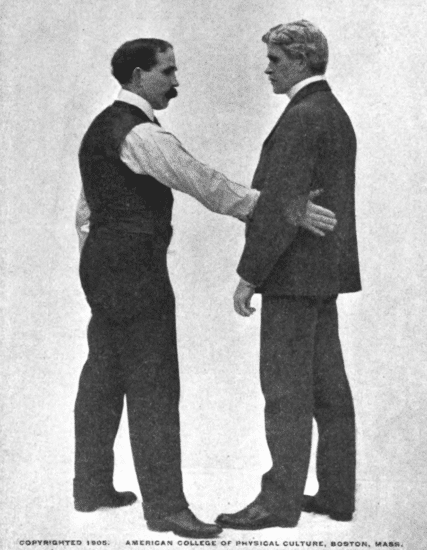
Place your right arm inside your opponent’s left as above illustrated, step to the right…
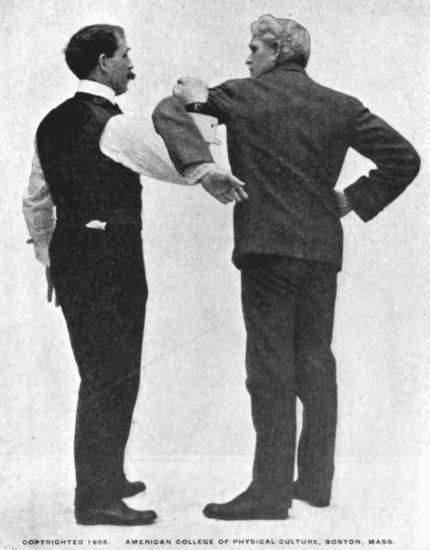
…and inward, raising your opponent’s arm as shown above…
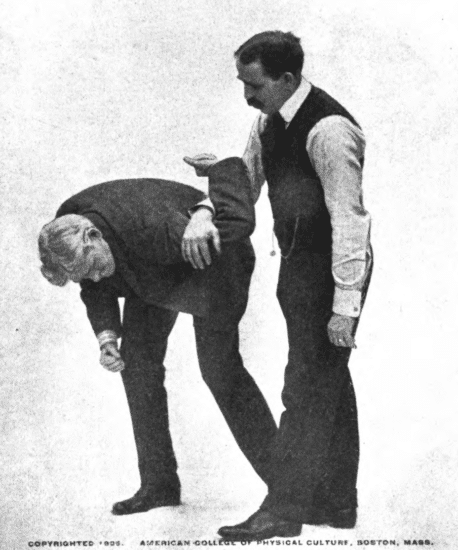
…forcing your opponent’s arm up, which will cause him to bend forward in great pain he cannot resist.
Lesson #16
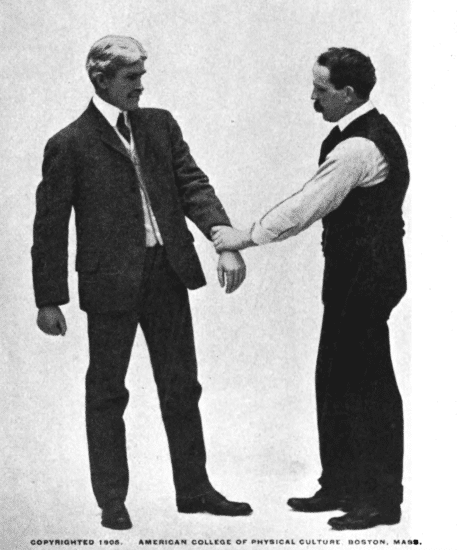
Take your opponent firmly by the left wrist with left hand as shown above…
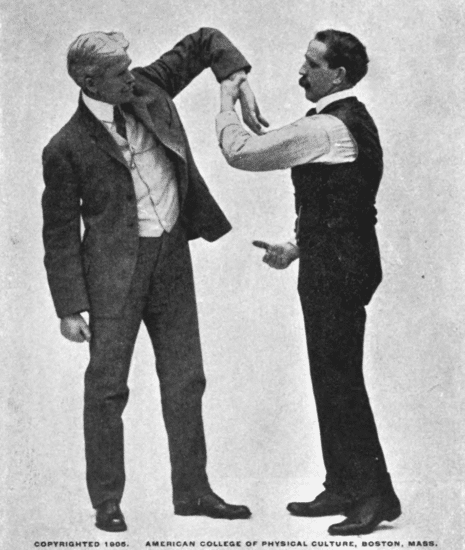
…force your opponent’s hand up and twist to the left, gripping firmly with your left, at the same time have your right ready to…
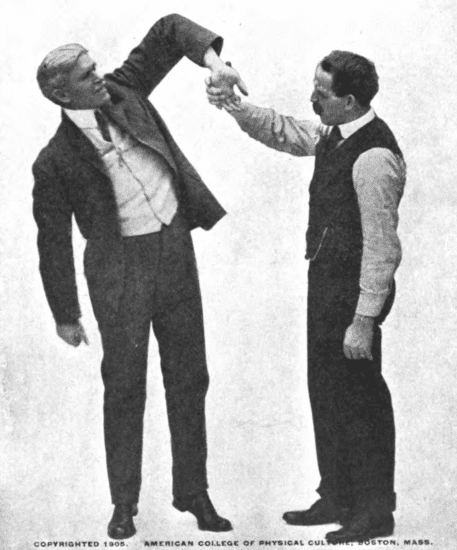
…take hold of your opponent’s left hand as above shown. You can then twist his arm at your will, which is very painful.
Lesson #17
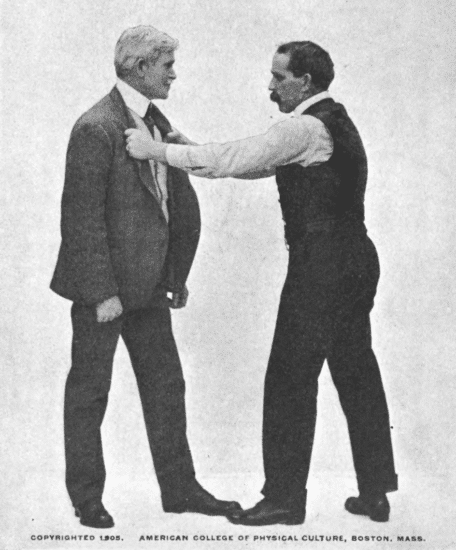
Should a person take hold of you by the lapel of your coat with the intention of doing you bodily harm…

…force your arms up between your opponent’s. This must be done quickly, and step forward.
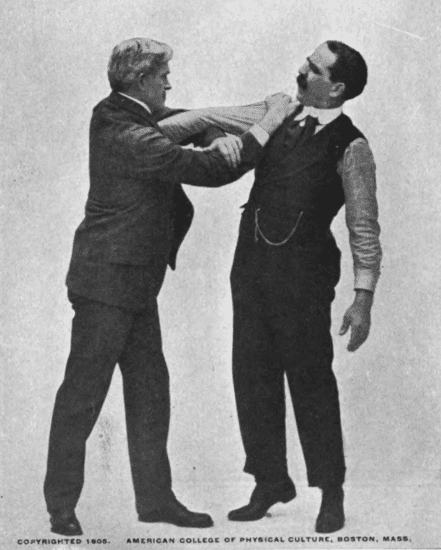
Bring your left arm outside and under your opponent’s right, placing your right to his shoulder and your left firmly on your right, which will cause your opponent much pain.
Lesson #18

Take your opponent’s lefthand with your right. Have the thumb rest on the back and your four fingers on the ball of his hand.
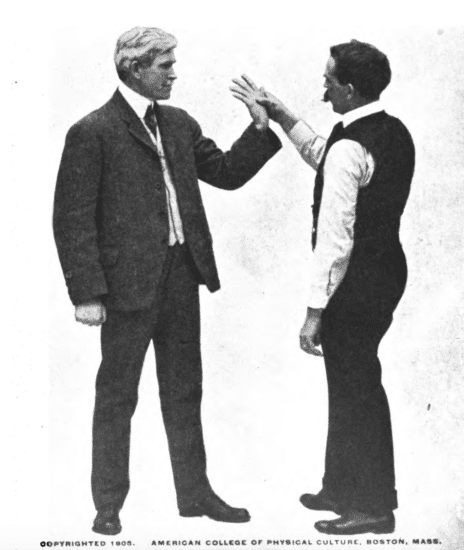
Raise the hand as indicated above, turning your opponent’s wrist to the right.

Hold firmly with your right and pass your left under the arm as above illustrated.
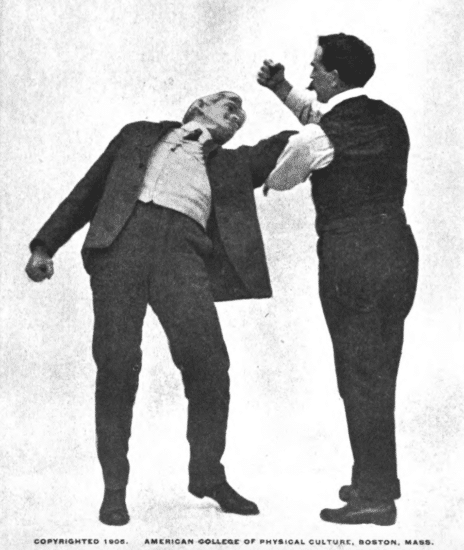
Grasp your opponent’s left at about the wrist with your left. Pressing downward you then have your right free and have opponent at your mercy.
Lesson #19
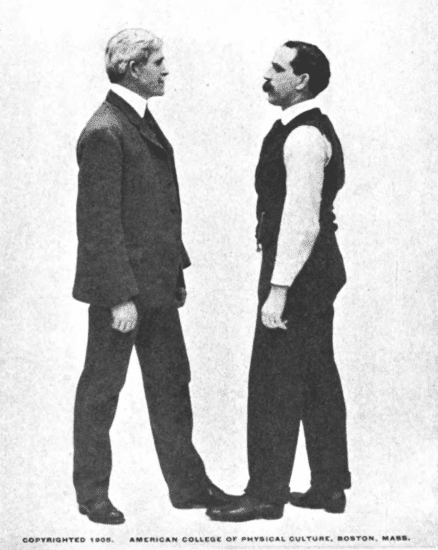
Should you get into an argument…
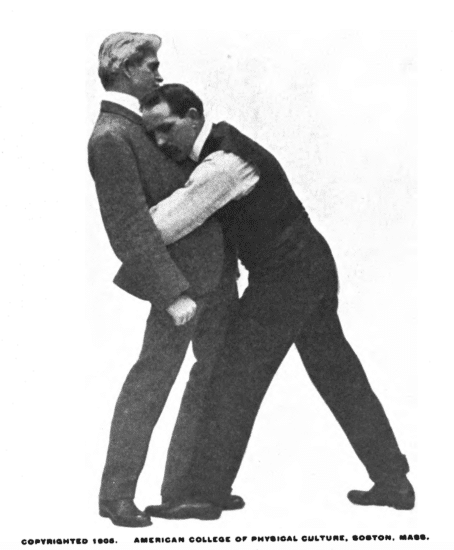
…and your opponent should clinch as above illustrated…
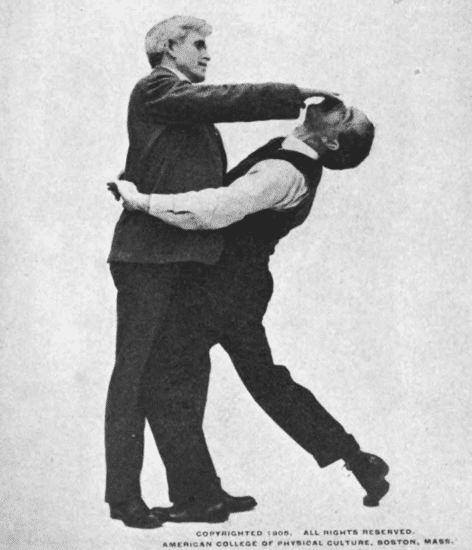
…place your right to opponent’s nose and push. He will be more than willing to release his hold.
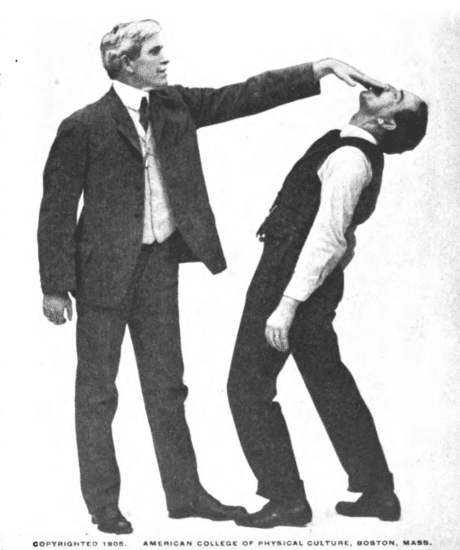
You can then follow up with your left, which leaves your right free to take hold, same as lesson W.
Lesson #20
Should a person point a revolver in your face to hold you up or otherwise, do not make a false move with either hand, keep cool.
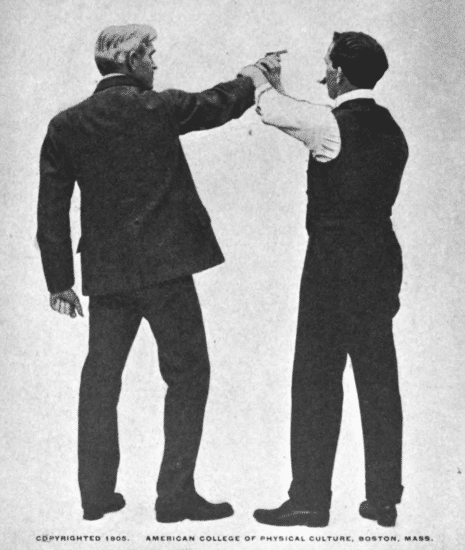
Direct your left to your opponent’s wrist, forcing his arm to the right, hold firmly, then grasp the back of the hand with your right.
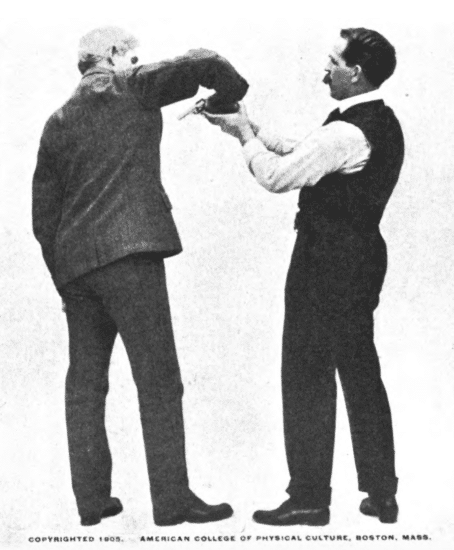
Hold firmly with your left, force inwardly with the right; this must be done quickly.

Turn your opponent’s wrist with your right, holding his arm up. You can then take the revolver from him with your left very easily. N. B. [observe carefully] This should be practiced by removing chamber from revolver.
Lesson #21
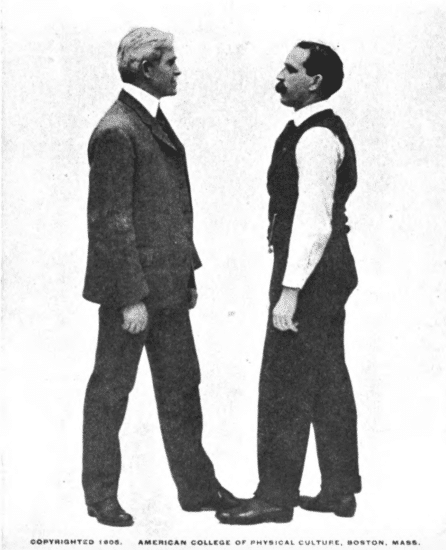
Should you become involved in an argument and your opponent…
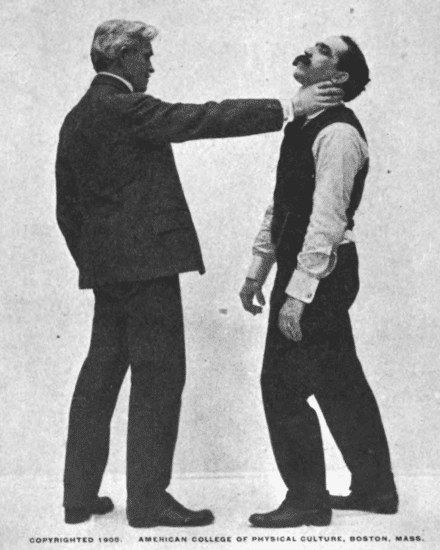
…grasps you by the throat, as above illustrated…

…take a firm hold of his index finger with your left, draw his hand up and to the left, run your right under his left arm.
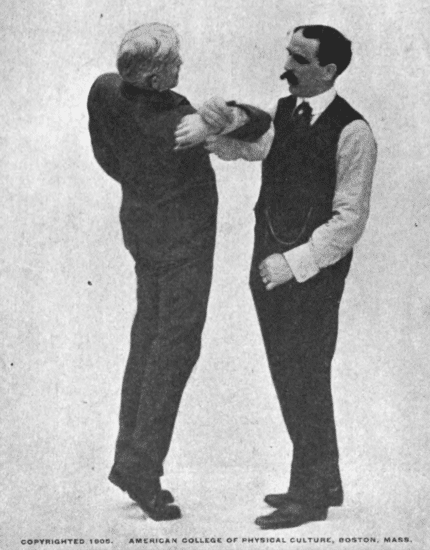
Place your wrist over your opponent’s, as above illustrated, pressing firmly down with your right. You have then reversed the positions and have your opponent at your mercy.
Tags: Self-Defense & Fighting




